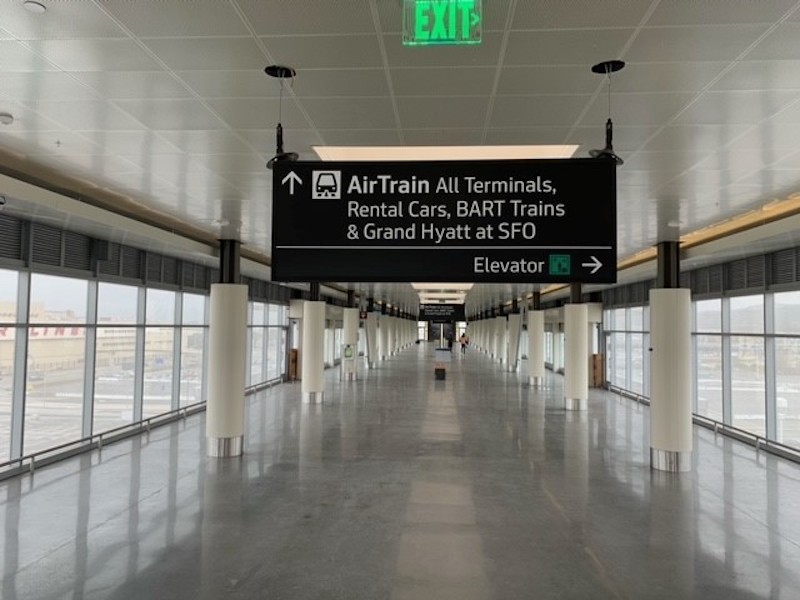In May, the San Francisco International Airport completed the extension of its AirTrain people mover system to its Long-Term Parking area. At that point, the AirTrain provided connectivity between all terminals, parking garages, an on-airport hotel, the city’s subway system, and the airport’s car rental center. Previously transportation between the long-term parking lot and the terminals had been provided by shuttle buses, and AirTrain’s extension is projected to eliminate 600,000 miles of trips annually, according to the airport.
This $259 million project, which launched in August 2016, extends the AirTrain guideways by 1,900 ft to reach the long-term parking lot. The project included the construction of two new AirTrain stations, each of which built under a $172 million progressive design-build contract with Skanska USA and WSP. The first station, located at the on-site Grand Hyatt hotel, opened to the public on October 2, 2019; the second station, with a pedestrian bridge that connects AirTrain to one of two Long-Term Parking multilevel garages, opened on May 5 of this year.
VERY GREEN STOPS
The construction project’s highlights include the installation of a 2,700-panel PV array on the roof of the long-term parking garage that will generate about two-fifths of the stations’ annual power needs. Water-efficient fittings and fixtures will cut the stations’ water use by 40%. Three-quarters of this project’s construction and demolition debris were recycled. The stations’ indoor air quality complies with LEED air quality assessment standards (prior to occupancy).
In total, more the 50 sustainable practices were implemented as part of the construction of the stations, which were certified LEED Gold in September. “Achieving LEED Gold certifications demonstrates our commitment to employing sustainable practices on every project we undertake,” said Tony Taddeo, Senior Vice President of Operations for Skanska USA Civil.

PGH Wong was its construction manager on the AirTrain extension project.
AirTrain, which has been in operation since 2003, currently consists of 41 electric vehicles that run along six miles of fully automated concrete guideways.
Related Stories
| Aug 11, 2010
GSA celebrates 60th anniversary
The U.S. General Services Administration today is commemorating its 60th anniversary as it engages in one of its its most challenging assignments ever—helping to achieve the goals of the American Recovery and Reinvestment Act.
| Aug 11, 2010
Earthquake engineering keeps airport grounded
Istanbul, Turkey's new 2.15 million-sf Sabiha Gökçen International Airport opened on October 31, 2009, becoming the world's largest seismically isolated building. Arup's global airport planning and engineering team, in collaboration with architects Dogan Tekeli Sami Sisa Mimarlik Ofisi and contractor LIMAK-GMR JV, working within an 18-month timeline, designed and built the facility wi...
| Aug 11, 2010
Manhattan's Pier 57 to be transformed into $210 million cultural center
LOT-EK, Beyer Blinder Belle, and West 8 have been selected as the design team for Hudson River Park's $210 million Pier 57 redevelopment, headed by local developer Young Woo & Associates. The 375,000-sf vacant passenger ship terminal will be transformed into a cultural center, small business incubator, and public park, including a rooftop venue for the Tribeca Film Festival.
| Aug 11, 2010
Special Recognition: Triple Bridge Gateway, Port Authority Bus Terminal New York, N.Y.
Judges saw the Triple Bridge Gateway in Midtown Manhattan as more art installation than building project, but they were impressed at how the illuminated ramps and bridges—14 years in the making—turned an ugly intersection into something beautiful. The three bridges span 9th Avenue at the juncture where vehicles emerge from the Lincoln Tunnel heading to the Port Authority of New Yor...
| Aug 11, 2010
29 Great Solutions
1. Riverwalk Transforms Chicago's Second Waterfront Chicago has long enjoyed a beautiful waterfront along Lake Michigan, but the Windy City's second waterfront along the Chicago River was often ignored and mostly neglected. Thanks to a $22 million rehab by local architect Carol Ross Barney and her associate John Fried, a 1.







